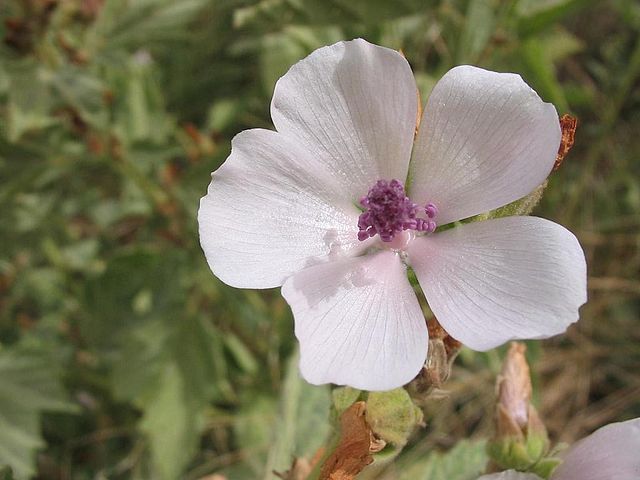Althaea officinalis
Species of plant From Wikipedia, the free encyclopedia
Althaea officinalis, the marsh mallow[2] or marshmallow,[3] is a species of flowering plant indigenous to Europe, Western Asia and North Africa, which is used in herbalism and as an ornamental plant.
This article has multiple issues. Please help improve it or discuss these issues on the talk page. (Learn how and when to remove these messages)
|
| Althaea officinalis | |
|---|---|
 | |
| Scientific classification | |
| Kingdom: | Plantae |
| Clade: | Tracheophytes |
| Clade: | Angiosperms |
| Clade: | Eudicots |
| Clade: | Rosids |
| Order: | Malvales |
| Family: | Malvaceae |
| Genus: | Althaea |
| Species: | A. officinalis |
| Binomial name | |
| Althaea officinalis | |
| Synonyms[1] | |
| |

Description
Summarize
Perspective
This herbaceous perennial grows to 180 cm (6 ft) tall and puts out only a few lateral branches. The whole plant is softly stellate-hairy, especially the leaves, which are broadly triangular to oval, often with 3-5 shallow lobes, irregularly toothed, with cordate to cuneate bases. Leaf size varies considerably, up to 100 mm (4 in) long, and 75 mm (3 in) wide. The leaves are arranged alternately along the stem, with no stipules, on petioles up to 45 mm (1.75 in).[4][5]
The inflorescences occur in the leaf axils and at the top of the stem and consist of panicles of 1-many flowers. The flowers are actinomorphic with 5 lilac/pink petals up to 2 cm long and 5 green sepals which are much shorter than the petals, and fused at the base. Below the petals is a cup-shaped epicalyx with 6-9 narrow, triangular lobes, half the length of the sepals. The purple stamens are united into a tube, the anthers kidney-shaped and one-celled. There is one style which protrudes above the stamen tube.[6][7]
The flowers are in bloom during August and September, and are followed, as in other species of this order, by the flat, round fruit which are popularly called "cheeses". The whole fruit is a schizocarp, about 1 cm in diameter, which splits into about 20 kidney-shaped mericarps (seeds) about 2 mm long.[6]
The common mallow is frequently called "marsh mallow" in colloquial terms, but the true marsh mallow is distinguished from all the other mallows growing in Great Britain by the numerous divisions of the outer calyx (six to nine cleft), by the hoary down which thickly clothes the stems and foliage, and by the numerous panicles of blush-coloured flowers, paler than the common mallow. The roots are perennial, thick, long and tapering, very tough and pliant, whitish yellow outside, white and fibrous within.
Phytochemicals
Chemical constituents include altheahexacosanyl lactone (n-hexacos-2-enyl-1,5-olide), 2β-hydroxycalamene (altheacalamene) and altheacoumarin glucoside (5,6-dihydroxycoumarin-5-dodecanoate-6β-D-glucopyranoside), along with the known phytoconstituents lauric acid, β-sitosterol and lanosterol.[8]
Uses
Summarize
Perspective
Ornamental
Marshmallows are used in gardening as ornamental plants.
Herbal medicine

The leaves, flowers and the root of A. officinalis (marshmallow) have been used in traditional herbal medicine. This use is reflected in the name of the genus, which comes from the Greek ἀλθαίνειν (althainein), meaning "to heal".[9][10][11] The Latin specific epithet officinalis indicates plants with some culinary or medicinal value.[12]
Marshmallow is traditionally used as relief for irritation of mucous membranes,[13] including use as a gargle for mouth and throat ulcers and gastric ulcers.[14][15]
Culinary
Most of the mallows have been used as food, and are mentioned by early classic writers with this connection. Mallow was an edible vegetable among the Romans; a dish of marsh mallow was one of their delicacies. Prospero Alpini stated in 1592 that a plant of the mallow kind was eaten by the Egyptians. Many of the poorer inhabitants of Syria subsisted for weeks on herbs, of which marshmallow is one of the most common.[citation needed] When boiled first and fried with onions and butter, the roots are said to form a palatable dish.[16] In times of scarcity consequent upon the failure of the crops, this plant, which grows in Syria in great abundance, is collected heavily as a foodstuff.
The young leaves can be cooked. The flower buds can be pickled.[17] The roots can be peeled, sliced, boiled and sweetened to make candy. Water used to boil any part of the plant can be used as an egg white substitute.[17]
Botanical gallery
- Typically upright and somewhat broad (Austria)
- Very tall narrow example (?Germany)
- Typical appearance in flower, closer, showing pale clustered flowers with purple centres (England)
- Inflorescence, showing pale clustered flowers with purple centres and velvetty, shallow-lobed toothy leaves with recessed veins and (if zoomed) soft-haired stem
- Flower cluster showing purple anthers and stigmas (Canada)
- Filaments join into a column, showing purple anthers and (when zoomed) purple pollen spheres (?Germany)
- Flowers, showing purple anthers when unopened (England)
- Unopened flower buds from side, showing epicalyces at bud (calyx) bases and velvetty plant stem (England)
- Unopened flower buds from above, showing tips of epicalyces that are at bud (calyx) base
- Fruits, showing hairs on smooth fruit surface
- Fruits, showing a cluster
- Velvetty leaves (Germany)
- Leaf, velvetty (here slightly)
References
Further reading
External links
Wikiwand - on
Seamless Wikipedia browsing. On steroids.












